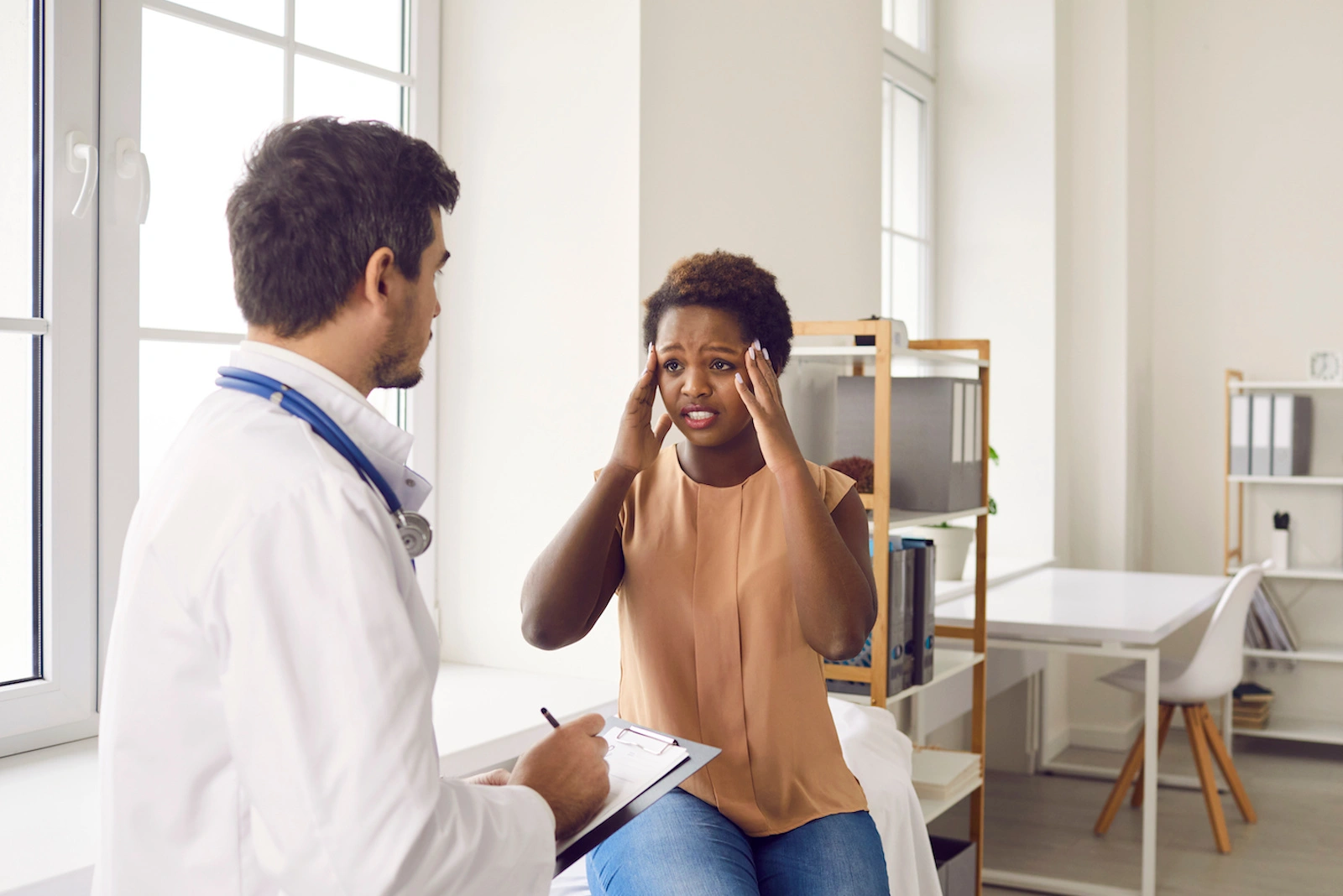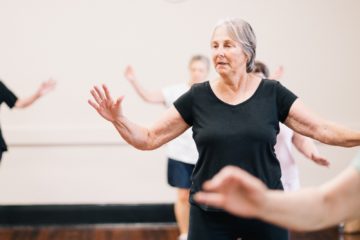Physical Therapy for Vestibular Migraine

Do you suffer from attacks of vertigo, nausea, vomiting, light, smell or sound sensitivity, and possibly severe headache that shuts you down for 1-3 days? You could be experiencing an episode of a little known condition called vestibular migraine. How can you find help? Come to Synergy and see our experienced vestibular physical therapist. A vestibular migraine specialist, your physical therapist will assess your symptoms, provide support and give you an individual treatment plan to put you in control and back on your feet.
What is Vestibular Migraine?
Vestibular migraine, as the name implies, is a type of migraine. However, 50% of the time, there is no headache associated with it. Vestibular migraine is a common cause of vertigo with benign paroxysmal positional vertigo (BPPV) being the most common. Vestibular migraine is a condition characterized by recurrent episodes of vertigo lasting up to 72 hours and can include symptoms of nausea, vomiting, photophobia (hypersensitive to light), phonophobia (intolerance to noise), headache – often one sided, and visual aura/disturbances. While vestibular migraine is a disorder related to the brain,according to the Vestibular Disorders Association, “approximately 40% of migraine patients have some accompanying vestibular syndrome involving disruption in their balance and/or dizziness at one time or another”, such as Meniere’s Disease and Superior Canal Dehiscence Syndrome.The vertigo and dizziness may feel like a rocking, floating or swaying sensation. Some people even feel as if they are moving on the inside of their bodies. This can be a very frightening experience the first time this occurs and the person often feels very anxious and may even seek emergency medical attention.
What Causes Vestibular Migraine?
Vestibular migraine is a neurological condition that is not fully understood, but seems to involve connections in the brain that control pain and input from the vestibular system. The brain becomes hypersensitive to sensory stimulation such as light and sound, and other triggers. According to the American Migraine Foundation, up to 3% of the adult population are afflicted with vestibular migraine and women are 5 times more likely to have it than men. There is likely a genetic, or at least a familial component because most who suffer from vestibular migraine have a history of childhood motion sickness and personal or family history of migraine. Vestibular migraine usually comes on spontaneously, though it is strongly influenced by hormonal, lifestyle, dietary and environmental factors. The attacks can be brought on by stress, altered sleep patterns, hormonal influences, illness and certain foods.
What Triggers Vestibular Migraine?
Risk Factors: Female age 30-50, history of childhood motion sickness, menstruation/hormonal fluctuations, stress, insomnia, dehydration, history of migraine, family history of migraine
Food Triggers: Caffeine, coffee, nicotine, alcohol, processed meats, aged cheese, red wine, monosodium glutamate (MSG), artificial sweeteners, foods with Tyramine in them, a compound found in plants and animals which comes from the breakdown of Tyrosine, which is added to aged and fermented foods, weather changes, chocolate, nuts and many others are possible
How is Vestibular Migraine Diagnosed
According to the National Institute of Health, these factors must be present to make a diagnosis of vestibular migraine:
- At least 5 episodes with vestibular symptoms of moderate or severe intensity, lasting 5 min to 72 hours
- Current or previous history of migraine with or without aura according to the International Classification of Headache Disorders (ICHD-3)
- One or more migraine features with at least 50% of the vestibular episodes:
- Headache with at least two of the following characteristics: one sided location, pulsating quality, moderate or severe pain intensity, aggravation by routine physical activity
- photophobia and phonophobia
- visual aura
- Not better accounted for by another vestibular or ICHD diagnosis
How Can Physical Therapy Help Vestibular Migraine?
On the first visit to physical therapy, your physical therapist will take a thorough history including past medical history, pattern of symptoms, prior treatment and test results. Your physical therapist will also ask you about lifestyle factors such as stress, diet, and sleep, looking for possible vestibular migraine triggers, as these play an important role in vestibular migraine.
After this, your therapist will perform a physical evaluation, being very careful not to provoke your symptoms too much, though the testing may bring on some. However, this is needed to help accurately determine the source of your symptoms. Testing will include assessing your dizziness, checking your balance, and testing your vestibular system. Working with a physical therapist can help determine if there are problems in the vestibular system itself, such as BPPV, and physical therapy is highly effective for this condition.
Your therapist will also look at your posture and assess your spine, because people with vestibular migraine often feel anxious about moving and limit their activity which can lead to muscle tension and joint stiffness, especially in their neck. This lack of movement can create secondary problems and even worsen the symptoms, so it’s important to assess. Physical therapy treatment for vestibular migraine can significantly help with these musculoskeletal symptoms, which are very often associated with this condition, as well as in other ways.
People with this disorder often feel anxious and even frightened about their symptoms because they don’t know what it is or how to make it better. However, working with a physical therapist for vestibular migraine can help you feel more in control and therefore less anxious, which in itself can help you feel much better. When anxious or stressed, a person will often have changes in the depth and rate of their normal breathing which can cause increased vertigo, dizziness, imbalance and nausea. Your physical therapist will help you identify those changes and instruct you in corrective and calming breathing exercises that will help alleviate stress, anxiety and dizziness.
One of the key ways physical therapy for vestibular migraine is effective is through education; which is a primary component of managing and reducing the severity and frequency of vestibular migraine attacks. While at present there is no cure for vestibular migraine, your physical therapist will help you become informed about how to best manage it, thereby reducing the severity and frequency of the symptoms. Your physical therapist will provide you with tools and the support you need to help you identify the specific things that trigger the attacks by tracking your symptoms. Once these triggers are known you can lessen and even prevent the onset severity and duration of these episodes.
One very important trigger that physical therapy for vestibular migraine can help with is stress management. Your physical therapist will help you identify stressors in your life and the impact stress has on your body. Your physical therapist will teach you ways to help relieve stress through various types of relaxation techniques, such as mindfulness, breathing exercises and aerobic exercise. Regular whole body exercise such as walking, biking, yoga, swimming, and Tai Chi can reduce the frequency and severity of symptoms and reduce the impact of negative stress, and may even reduce your need to use migraine medications.
Some people with vestibular migraine have a problem known as visual motion sensitivity, which is defined as vertigo/dizziness worsened by visual/motion stimulation such as scanning for items in the grocery store, scrolling on your phone or computer, moving objects, or walking in a crowd especially in a visually busy environment. Your therapist will perform tests to see if it’s present and will gently guide you through habituation exercises that will reduce the sensitivity and allow you to do these kinds of activities without the dizziness.
In summary, seeing a physical therapist can be very helpful for vestibular migraine, and other vestibular disorders. First of all, physical therapy can effectively treat the musculoskeletal and vestibular components often associated with vestibular migraine, lessening or even abolishing the dizziness and restoring your freedom to move. Vestibular therapy consists of gentle habituation exercises that will desensitize your nervous system to provocative head or body movements, and even visual motion triggers, which helps to prevent triggering another attack of vestibular migraine. Your physical therapist will teach you about possible migraine triggers and provide education about how to make the lifestyle changes needed to lessen the symptoms, and provide the support you need to help you succeed in making these changes. Many patients working with a skilled vestibular physical therapist also experience a renewed sense of hope and less anxiety when they learn about vestibular migraine and how it can be improved. Physical therapy can help you feel and function better! Contact Synergy to schedule a visit today.
